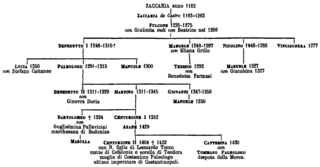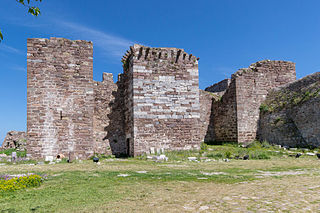Sources
- Miller, William (1921). "The Zaccaria of Phocaea and Chios (1275-1329)". Essays on the Latin Orient. Cambridge: Cambridge University Press. pp. 283–298.
Tedisio Zaccaria was lord of Thasos and governor of Phocaea from 1302 to 1307. A descendant of the important Genoese family of Zaccaria, he was the son of Manuele Zaccaria and Clarisia Fieschi. His father was the brother of Benedetto I Zaccaria, the founder of Zaccaria fortunes in Byzantium and Latin Greece.
He was appointed governor of Phocaea by his uncle Benedetto I and remained in office after his death, when he became governor of the Lordship of Chios. In 1306 Tedisio campaigned in Thasos, where he captured the castle and made the island his fief. In 1307 Benedetto II Zaccaria decided to replace to Tedisio with a new governor.
The new governor, Andriolo Cattaneo, sent his son Domenico against Tedisio, and took over Phocaea. Tedisio then fled to Gallipoli where he sought the support of the Catalan Company. In 1307 he campaigned against Phocaea. After a siege he captured the city, but he was unable to keep it under control, and was forced to retreat to Thasos to defend his fief. The Catalan historian Ramon Muntaner refers in his Chronicle that the raid into the castle of Phokaia allowed Zaccaria to take with him the relics of the Holy Cross, a white shirt made by the Virgin Mary, and a codex with the Apocalypsis, all of them taken after the Turkish conquest into Pholaia from the tomb of Saint John, the author of the Gospel, in Ephesos. The fragments of the Holy Cross were given to the same Muntaner, as he was the Chancellor of the Catalan Company, while Zaccaria retained the other relics. Zaccaria remained lord of Thasos until 1313, when the island was reconquered by the Byzantines.
Year 1304 (MCCCIV) was a leap year starting on Wednesday of the Julian calendar.

The Catalan Company or the Great Catalan Company was a company of mercenaries led by Roger de Flor in the early 14th century and hired by the Byzantine Emperor Andronikos II Palaiologos to combat the increasing power of the Anatolian beyliks. It was formed by almogavar veterans of the War of the Sicilian Vespers, who had remained unemployed after the signing in 1302 of the Peace of Caltabellotta between the Crown of Aragon and the French dynasty of the Angevins.

Centurione II Zaccaria, scion of a powerful Genoese merchant family established in the Morea, was installed as Prince of Achaea by Ladislaus of Naples in 1404 and was the last ruler of the Latin Empire not under Byzantine suzerainty.

The Lordship of Chios was a short-lived autonomous lordship run by the Genoese Zaccaria family. Its core was the eastern Aegean island of Chios, and in its height it encompassed a number of other islands off the shore of Asia Minor. Although theoretically a vassal of the Byzantine Empire, the Zaccaria ruled the island as a practically independent domain from its capture in 1304 until the Greek-Byzantines recovered it, with the support of the local Greek population, in 1329.

Martino Zaccaria was the Lord of Chios from 1314 to 1329, ruler of several other Aegean islands, and baron of Veligosti–Damala and Chalandritsa in the Principality of Achaea. He distinguished himself in the fight against Turkish corsairs in the Aegean Sea, and received the title of "King and Despot of Asia Minor" from the titular Latin Emperor, Philip II. He was deposed from his rule of Chios by a Byzantine expedition in 1329, and imprisoned in Constantinople until 1337. Martino then returned to Italy, where he was named the Genoese ambassador to the Holy See. In 1343 he was named commander of the Papal squadron in the Smyrniote crusade against Umur Bey, ruler of the Emirate of Aydin, and participated in the storming of Smyrna in October 1344. He was killed, along with several other of the crusade's leaders, in a Turkish attack on 17 January 1345.

Benedetto I Zaccaria was an Italian admiral of the Republic of Genoa. He was the Lord of Phocaea and first Lord of Chios, and the founder of Zaccaria fortunes in Byzantine and Latin Greece. He was, at different stages in his life, a diplomat, adventurer, mercenary, and statesman.

BartolomeoZaccaria was the first husband of Guglielma Pallavicini and thus Marquess of Bodonitsa in her right. He also carried the title Lord of Damala during his lifetime.

Paleologo Zaccaria was the Lord of Chios and Phocaea, as well as other Aegean islands from 1307 until his death.

Boniface of Verona was a Lombard Crusader lord in Frankish Greece during the late 13th and early 14th century. A third son from a junior branch of his family, he sold his castle to equip himself as a knight, became a protégé of Guy II de la Roche, Duke of Athens, expelled the Byzantines from Euboea in 1296, and advanced to become one of the most powerful lords of Frankish Greece. Following Guy II's death, he served as regent for the Duchy of Athens in 1308–09, and was captured by the Catalan Company in the Battle of Halmyros in March 1311. The Catalans held Boniface in high regard, and offered to make him their leader. Boniface refused, but retained close relations with them, sharing their hostility towards the Republic of Venice and its own interests in Euboea. Boniface died in late 1317 or early 1318, leaving his son-in-law, the Catalan vicar-general Alfonso Fadrique, as the heir of his domains.

The Frankokratia, also known as Latinokratia and, for the Venetian domains, Venetokratia or Enetokratia, was the period in Greek history after the Fourth Crusade (1204), when a number of primarily French and Italian states were established by the Partitio terrarum imperii Romaniae on the territory of the dissolved Byzantine Empire.

The Zaccaria family was an ancient and noble Genoese dynasty that had great importance in the development and consolidation of the Republic of Genoa in the thirteenth century and in the following period. The Zaccarias were characterized by, according to scholarly handwritten documents of the time, having broad intelligence and their effective way of maintaining political power through manipulation.
Benedetto II Zaccaria was the co-Lord of Chios, as well as many other Aegean islands from 1314 until ca. 1325.

The Barony of Chalandritsa was a medieval Frankish fiefdom of the Principality of Achaea, located in the northern Peloponnese peninsula in Greece, and centred on the town of Chalandritsa south of Patras.
The Battle of Chios was a naval battle fought off the shore of the eastern Aegean island of Chios between a Latin Christian—mainly Hospitaller—fleet and a Turkish fleet from the Aydinid emirate. The Christian fleet was resoundingly victorious, but for the Aydinids, who had been engaging in piracy since the collapse of Byzantine power, it was only a temporary setback in their rise to prominence.
Manuele Zaccaria was the Genoese lord of Phocaea and its profitable alum mines, which he received as a fief from the Byzantine Emperor, from 1275 until his death in 1287/88. He was succeeded by his brother, Benedetto I Zaccaria.
Leo Kalothetos was a provincial governor of the Byzantine Empire.
The Lordship of Phocaea was founded after in 1275, when the Genoese nobleman Manuele Zaccaria received the twin towns of Old Phocaea and New Phocaea as a fief from the Byzantine emperor Andronikos II Palaiologos. The Zaccaria family amassed a considerable fortune from their properties there, especially the rich alum mines. The Zaccaria held the lordship until 1340, when it was repossessed by the Byzantines under Andronikos III Palaiologos.

The Ottoman conquest of Lesbos took place in September 1462. The Ottoman Empire, under Sultan Mehmed II, laid siege to the island's capital, Mytilene. After its surrender, the other forts of the island surrendered as well. The event put an end to the semi-independent Genoese lordship that the Gattilusio family had established in the northeastern Aegean since the mid-14th century, and heralded the beginning of the First Ottoman–Venetian War in the following year.
The Hospitaller conquest of Rhodes took place in 1306–1310. The Knights Hospitaller, led by Grand Master Foulques de Villaret, landed on the island in summer 1306 and quickly conquered most of it except for the city of Rhodes, which remained in Byzantine hands. Emperor Andronikos II Palaiologos sent reinforcements, which allowed the city to repel the initial Hospitaller attacks, and persevere until it was captured on 15 August 1310. The Hospitallers transferred their base to the island, which became the centre of their activities until it was conquered by the Ottoman Empire in 1522.
The Zaccaria family was an ancient and noble Genoese dynasty.